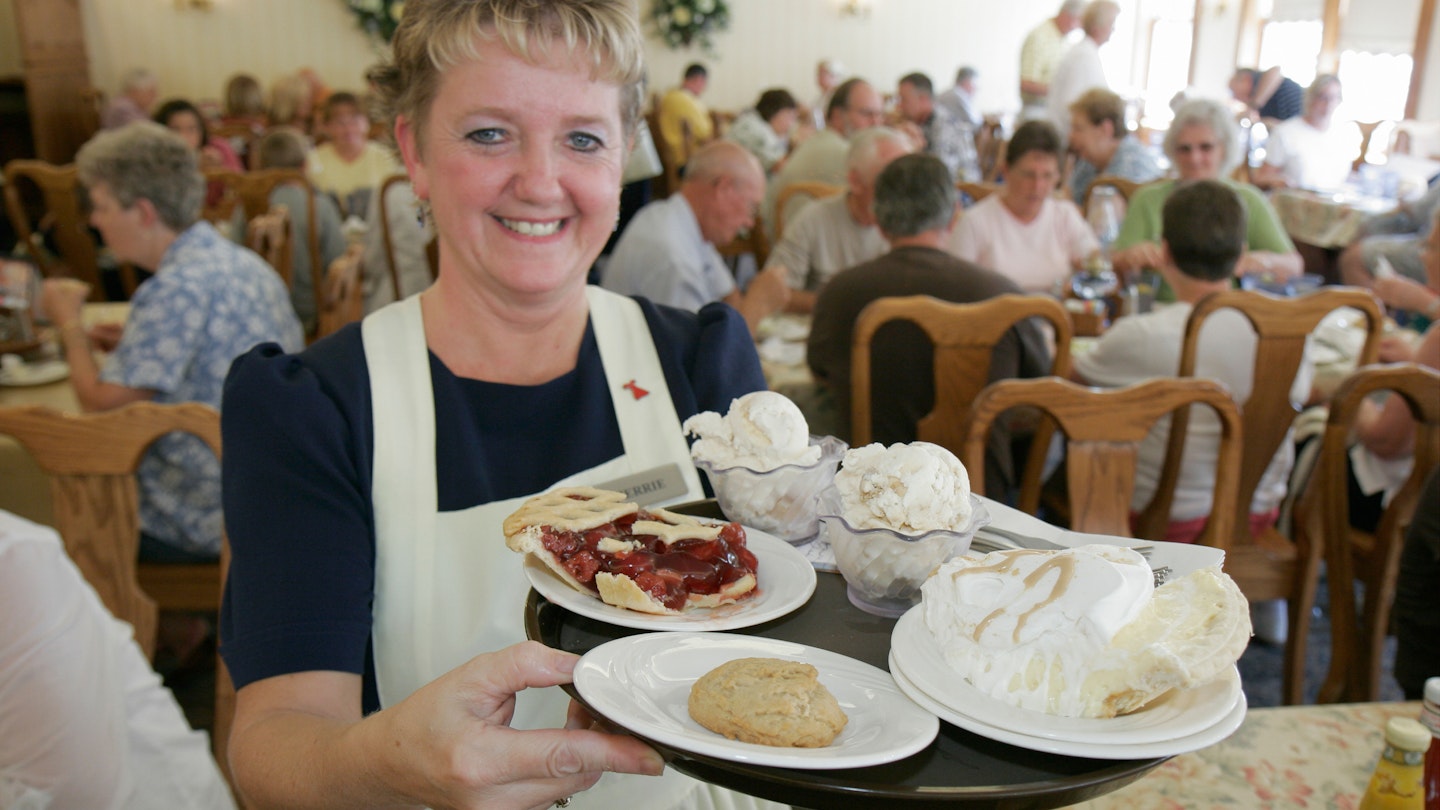Strawberry pie, blueberry pie, cherry pie. Fluffy lemon meringue and gooey, crunchy pecan. Chocolate cream, banana cream, coconut cream, all piled high with gravity-defying layers of whipped topping.
I’ve never forgotten the lineup of pies at Gray Brothers Cafeteria in Mooresville, Indiana, 10 miles south of Indianapolis International Airport. As a child growing up in nearby Bloomington, an excursion to Gray Brothers, where there’s always pie for dessert, was an extra special treat. Consequently, it’s the pie that still draws me to this Indiana institution whenever I’m back in the Hoosier state.
With more than 400 seats behind its limestone facade, Gray Brothers, which opened in 1944, is just one of the cafeteria-style restaurants that remain popular across Indiana. Moreover, Indianapolis-based author Sam Stall notes, “Indiana seems to have this weird proclivity for cafeterias.”
Indiana has plenty of old-school diners, like The Oasis in Plainfield or Nick’s Kitchen in Huntington, serving all-day breakfasts alongside classic Hoosier dishes like pork tenderloin sandwiches, where the fried breaded meat overflows out of its bun. The state also boasts soul-food restaurants that draw on Black culinary traditions, alongside all-you-can-eat buffets, including the Amish-owned Blue Gate Restaurant in Shipshewana, where patrons can fill up on soups, roast beef, and mashed potatoes for one price.

However, for many Hoosiers, cafeterias hold a special place in our hearts. You pick up a tray and slide it along the metal railing, choosing from an array of options: salads, hot dishes, vegetable sides, and freshly baked rolls, cakes, and pies – especially pies. You help yourself to the cold dishes, which are pre-plated and set behind glass partitions. As you move down the line, servers stand ready to scoop up your requested main dish and its accompaniments, handing you a heaping plate.
“You get to see what you’re going to eat before you order it,” explains Casey McGaughey, president of MCL Restaurant & Bakery, which his grandfather Charles founded as MCL Cafeteria in 1950. “You can shop with your eyes.”
A Brief History: Indiana’s First Cafeterias
Cafeterias aren’t unique to Indiana. Like many states across the US Midwest and South, Indiana was once home to numerous cafeteria-style eateries.
One of the first launched in Indianapolis in 1900 as Laughner’s Dairy Lunch. The Laughner family eventually operated a dozen Laughner’s Cafeterias in Indiana. By the mid-1900s, its dining rooms were decorated in a faux Tudor style, but its homey menus were not much different than what cafeterias still offer today. Laughner’s operated in the region for more than 100 years.
Moreover, in the mid-20th century, when the food industry focused on efficiency and mechanization, cafeterias were seen as innovative ways to deliver food. They served a broader population at a time when dining out had been a luxury. “A big key in the founding of MCL was to bring good, affordable food to everybody,” explains McGaughey.
Among the 13 locations that MCL currently runs in Indiana, Illinois, and Ohio, their Indianapolis branch on 10th St and North Arlington Ave has been serving for 70 years, making it the chain’s oldest still-operating location.
Indiana was also associated with Jonathan Byrd’s, which claimed to be the largest privately owned cafeteria in the US. Byrd proposed that drivers could pull off the highway at a roadside cafeteria and quickly load up their plates with a full, homemade meal, a revolutionary idea in the pre-fast-food era.

What to Eat on the Cafeteria Line
If the word “cafeteria” brings to mind school-lunch mystery meat or dreary hospital fare, think again.
Fried chicken is the must-try main dish at Indiana’s cafeterias. Both its light- and dark-meat versions are among the most popular dishes at Gray Brothers and MCL. This crunchy-skinned poultry, which somehow stays crispy on the cafeteria line, is a Hoosier staple, long served in farmhouse kitchens and at family dinners on Sundays after church.
Another popular cafeteria offering, according to Indianapolis-based food writer Jolene Ketzenberger, is the roast beef Manhattan. This open-faced sandwich, which locals claim was invented in Indianapolis, starts with sliced roast beef on white bread. “You cut the sandwich in half diagonally,” she explains. “Then you put a scoop of mashed potatoes in the middle and pour gravy over the whole thing.”
On Indiana’s cafeteria lines, you’ll also find hot dishes like meatloaf, chicken and noodles, and fried catfish, along with homestyle sides such as macaroni and cheese, mashed potatoes and gravy, green beans, and collard greens. Diners are not looking for anything “terribly complicated or esoteric,” says Ketzenberger; they crave traditional homemade dishes served in hearty portions.
Warm rolls are always available, or you might choose a fresh-from-the-oven cinnamon bun. However, the true star is decidedly the pie. “That’s the dessert that cafeterias are known for,” explains Ketzenberger, who recommends sampling two Indiana pie specialties: sugar cream pie, a custard-filled pastry unofficially dubbed the state pie, and persimmon pudding, a late-autumn classic dessert that resembles a moist cake, often served with whipped cream.
Don’t Wait to Try a Hoosier Cafeteria
In 1988, food writers Jane and Michael Stern noted that “many cafeterias are helping to preserve a regional cuisine that is unadulterated by faddishness.” With the ongoing popularity of Indiana cafeterias like Gray Brothers and MCL, this statement remains relevant today.
Yet, Stall expresses concern that this Hoosier food tradition may be at risk, with only a handful of popular cafeterias still flourishing. Therefore, if you want to have another cafeteria meal, he advises, “do it now.” As Casey McGaughey succinctly states, “everything’s better with pie.”





